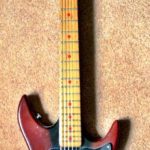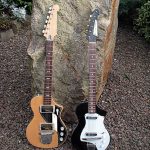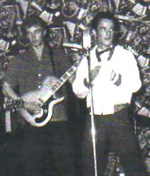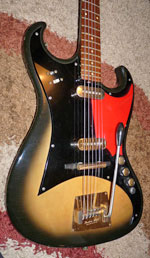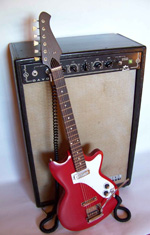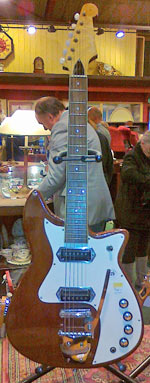Guestbook
Thanks for visiting The Guitar Collection!
If you would like to leave a comment for the Guestbook contact me: guy@theguitarcollection.org.uk
Fenton Weill Mono Tone
Hi Guy,
Super site!
Thanks for putting up your pages, have you ever seen a single pickup Dual Tone? My friend Will christened this a Fenton Weill Mono Tone, just to be funny! It is a bit dusty, I should have cleaned it up before I took the pic, but looks like a factory original single pickup without trem. Do you have any information on this model please?
I have most of an early Burns-Weill too, but had to cobble together the scratchplate and electrics . . . You can see the similarity to the Guyatone model here, thought it might give you a chuckle.
Keep up the good work!
Matt
Futurama
Nice site.
In the early ’70s I bought a Futurama 6-string bass from a junk shop in Oldham – I thought it was a guitar – if not an extremely heavy one. Anyway it was missing the top “E” string so i went to a music shop in Deansgate with a piece of string the length of the “E” string and the only one they could match it with was cello string! Can’t see a pic of it in your Archive but wish I still had it.
Phil.
Guy's Response:
Hi Phil,
Thanks for your email and comments. I hadn’t heard of a Fururama bass 6 string so I contacted Paul Day and here are his comments:-
Selmer imported the Hagstrom Coronado Basses (4 and 6 string) under the Futurama brandname in 1963/4. Neither model crops up very often over here and, in keeping with my fondness for baritone guitars, I still have a hankering for the six-string version. I know of one in captivity but the owner wants more than I’m willing to pay and, actually, his example may have once belonged to me as I did have one but foolishly, in hindsight, parted with it many years ago. A current price should be around £350, after all, who wants such a niche market quirky beast, apart from me that is!
All the best,
Guy.
Tremo Twenty
Just to let you know there is another one!
I bought it from someone at work in about 1967. The model no was 1978 and it was red. It came with a grey/blue “cardboard” carrying case and skinny red leather carrying strap.
In the ’80’s I lent it to a workmate who lost the tremelo arm and returned the guitar with the carrying case smoke damaged due to a house fire.
Controls crackly and some paint chipped.
Didn’t realise there were so few of them about.
Regards,
Terry.
Guy's Response:
Hello Terry,
Thanks for your message – interesting to know that another one has surfaced. I now know of 2 others branded Tremo Twenty – one is in a aguitar museum in Switzerland and the other, by a strange coincidence, belongs to someone just six miles from where I live in Cornwall. Of course there were plenty of guitars branded Top Twenty but obviously very few “Tremos”.
Best wishes,
Guy.
Watkins Rapier
Hi Guy,
I hope alls well with you. I thought I would send you some photos of the 1963 Watkins Rapier I bought.
All original parts on it, except the scratchplate. My daughter works at a film Studio. She got a guy who works there to put the gold Watkins logo on the new scratchplate (cool eh!) I’ve had it checked and set up. The machine heads needed attention. But we managed to get 4 original 1963 heads, to replace the damaged ones. I’m so happy with it . It sounds great. As I’m a better player than I was in 1964 I can play 4 chords now!
Alan
Swinging Blue Jeans.
Guy's Response:
Hi Alan,
I was really pleased to know that you’ve managed to buy an early Rapier which I know you’ve been looking for for some time – complete with the “Pifco” switch and the vibrato arm which is, as you know, so often missing. They are pretty rare in this condition and yours looks great too!
Please let me know if you ever plan to use it with the SBJs’ as I’d love to have a photo of you playing it live with the band for the Archive page of my website.
Glad to know that you can play 4 chords now – that’s 4 more than I can play, as you know!!!
All the best,
Guy.
Supersound Vibrato unit
Hi Guy
Thanks for your reply – I’ve heard from Paul (thanks for forwarding my email!) and am very interested by this info from the Weills regarding Roger…
I’ve also now got the mysterious body blank and Roger’s fitted neck in hand… the guys who bought the Roger factory stock advise me that they originally had 4 guitar bodies, all sycamore but 3 with Mahogany veneering front and back. Plus one Bass body, again mahogany veneered. I’ve never heard of Burns veneering bodies, but perhaps it was a refinement of the plastic plate seen over the back of some very early models? Paul seemed to suggest that this plate and the sometimes-seen raised area under the volume/tone controls etc was a result of having to work around the unavailability of wood of the correct thickness. He mentioned your Ike Isaacs-ish one as having an added Oak front?
I’ve read on Stephan Loss’ site shlaggitarren.de that Roger’s archtop sales slumped c.61/62 and they turned to importing solidbodies…
If there is no connection between Weill and Roger, my latest revised theory is that perhaps Jim Burns had parted from Weill with a stack of uncompleted RP2G bodies without necks, and having moved on to other designs offloaded them (somehow) to Roger? How that might happen, and why he wouldn’t simply reshape them and reuse the wood himself, I don’t know.
The bodies do seem identical, in particular there is a sharp edge on the body in the middle of the flat bottom-edge ‘base’, where the wrap-around tailpiece might have sat. Roger’s model had a face-mounted vibrato unit, so this sharp ledge would make no sense for his design. You can just about make it out in outline of the catalogue photo.
Weird, eh? Well… I love a mystery!
All the best – and let me know if you have any ideas!
Jon
Guy's Response:
Hi Jon,
Thanks for your message and the interesting photo of a Roger guitar which appears to have a Burns Weill Super Streamline body and a Roger neck.
By the way, you no doubt noticed my “deliberate” mistake (being a drummer!) when I previously referred to “Roger” guitars as “Rogers” guitars – Roger, of course, being the name of Wenzel Rossmeisl’s son, after whom he named the guitar brand.
When Jim Burns parted company with Supersound (for more information see the Jim Burns page of the Supersound website), he did take the Ike Isaacs bodies with him–hence the appearence of several “Burns” and Burns Weill versions of this guitar appearing for sale in early 1959. However when Jim Burns split with Henry Weill it was something of a clean break and he left all the BW bodies with Henry. In fact he was actually marketing the Burns Artist guitar by December 1959.
So the bodies which you mention would have come from Henry Weill and, no doubt, Henry Weill would have supplied then as a result of meeting Wenzel at the Frankfurt show where he had a stand which displayed complete guitars and components.
I checked with Paul Day about the veneering and he confirms that he’s never seen a veneered Burns Weill instrument so he concludes that the veneering was carried out by Roger.
Incidently when Paul Day interviewed Henry Weill, prior to writing the Burns Book in the mid 1970s, he recalls a garage full of guitar bodies left over from when production ceased in c.1965! When we met Betty Weill recently we asked what had happened to these bodies and she told us that they had been put in a skip many years previously!
All the best,
Guy.
Supersound Vibrato unit
Hi Guy!
As a long-time late-night admired of your collection and website, I thought I should write and ask if you could offer any advice regarding a vibrato unit which I recently bought on ebay and I’ve never seen one before… it looks to be a completed unit (missing the bridge) of the Wooton-designed Supersound vibrato for guitar (for which blue-print drawings from August 1960 appear online on the Supersound website).
I bought it because I’m currently trying to assemble the parts to build a fantasy ‘New Old Stock’ Burns-Weill RP2G Super Streamline, and intended to use this unit in the build… I have a Roger-built body and neck (I am certain circumstantially that Roger were briefly supplying woodwork to H Weill after Burns departed, but before the design was refined and went 6-a-side on the headstock), and plan to flesh it out with era-correct suitable parts and some modern Adeson Classic Brit Pickups…
I guess you’ve seen the speculations about the Roger/Weill connection here?
Incidentally, has anyone to your knowledge ever seen a true Burns-Weill RP2G guitar? Basses, yes – several, but the six-stringers? I’ve only seen the photo in Per Gjorde’s book, which has ‘burns’ clipped from the badge… clearly indicating that it was made post-Jim Burns’ involvement…
Have you any reference photos of Super Streamlines which might help me on my way?
Kind Regards, and thanks for sharing all you have online!
Jon
—
Jon Free
*www.blackguitars.com*
*www.tin-tone.com*
Guy's Response:
Hi Jon,
Thanks for your message and kind comments on my site.
Re; the Supersound Vibrato unit (see the Supersound website for more music accessories). A number of these appeared for sale a year or two ago – evidently they turned up in a shop in London and yours is one of these.
Re; the Rogers connection to Burns Weill. Rogers never supplied woodwork to Henry Weill although Henry may have given or sold a neck and/or body to that company when he did the Frankfurt show. Although Paul Day was certain of this (Paul did a recorded interview with Henry in the 70s, and I have a copy, prior to writing “The Burns Book”) we did double check with Betty Weill when we met her and she confirmed that Rogers had never supplied any woodwork to Henry.
Paul Day has a library of over 2,000 different guitar brands and within this has details of the RP2G guitar. You can contact him direct and I’m sure he will be happy to help.
I do hope my reply has dispelled the myth of the Rogers connection to Henry Weill!
I’ll look forward to seeing photos of your fantasy “new old stock” Burns Weill when its completed.
All the best,
Guy.
Rare sighting of USO (Unidentified Supersound Object)
Hi Guy
(More information on Supersound Guitars can be found at the Supersound website.)
Apologies for using an old email to convey a new subject, but I wanted to ensure it arrived okay and I’m not sure which of your seemingly many email addresses is currently functioning!
So, what do you think of this six-string being earnestly strummed by one of the members of Rory Blackwell & The Blackjacks, way back in 1959. The more I peruse the pic, the harder it is to work out just what there is on board a very familiar – looking chassis, but that scratchplate is a dead giveaway for a start. I look forward to hearing your comments, so give me a ring when it’s convenient.
All the best,
Paul Day.
Guy's Response:
Hi Paul,
So a picture of another Burns Short Scale guitar has surfaced – amazing after over 50 years! There is no question that that is what it is and this one is a single pick-up version too. In fact the only single pick up instrument that has come to light. I wonder if its still in existence today?
I’ve done some research and I think the guitarist is Kenny Fillingham so I hope that if he reads this, or anyone who knows him or gigged with him looks at my website, he or they will contact me. (Of course I’m always delighted to hear from anyone who owns or has pictures of old, rare or unusual vintage electric guitars).
Thanks again for forwarding on the picture.
All the best,
Guy.
Fenton Weill question from the Pacific Northwest…
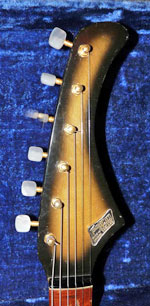
Hi Guy
Greetings from Seattle!
Please forgive the unsolicited attachment! Got this beautiful instrument from the original owner, who apparently purchased it in London in the early 60s while he was in the Army stationed in the UK.
I’m having a difficult time finding any information (other than the obvious…erm…Fenton Weill, London….)… I was curious, given the breadth of your gorgeous Anglocentric guitar collection, if you could tell me ANYTHING about it?
I am aware of the Weill/Burns history – just haven’t found another photo of a comparable guitar. I have to say the SOUND of this instrument is spectacular! Quiet pickups (like a humbucker) and a sweet bold tone. PLUS the previous owner says that these are the ORIGINAL strings!
ANY guidance would be greatly appreciated!
Sincerely,
Greg
Guy's Response:
Hi Greg,
My apologies for taking so long to reply to you but i just wanted to double check a few facts with Paul Day, who is the UK vintage guitar expert, before replying.
Your guitar is a rare Fenton Weill Twistmaster from the short lived Twister series and the only price list we can find dates this to late 1962. In the UK it retailed at 70 gns (Guineas – a Guinea was £1 and 1 shilling. Today that would be £1-05p). That was lot of money in the UK at that time as, I think, an average wage then was about £12 per week.
A leaflet on the Twister range describes it as the “Fenton Weill American Label guitar” with “high gain pick-ups”, a “featherlite Vibrato which cannot be improved in any way”. Also the “tuss rod is controlled from a counter sunk Allen nut at the blunt end of the fingerboard” with a 1/4 turn producing 1/8″ on the neck of the guitar.
You may also be interested to know that I recently had the pleasure of meeting Betty Weill who with her husband Henry owned and ran the Fenton Weill Company. You will see a couple of pictures from that meeting on my Archive page and the first Fenton Weill factory really was their garage although they moved production to a factory unit in about 1962. Incidently Henry Weill and Jim Burns ceased working together in December 1959.
All in all its a very rare and interesting guitar and it seems in very good condition too. Thank you so much for bringing it to my attention.
Best wishes,
Guy.
Gregg’s response:
Hello Guy,
A very sincere thank you for all the information! And could there possibly be a more perfect name for this guitar than the “Twistmaster”?!? Spectacular!!!
When I got the guitar I was woefully unaware of the Fenton Weill story….(I mainly collect Rickenbackers…. and oddball 60s Hagstroms).
When I first saw the guitar (and before I read the label) it looked very “Burns-like” (and after learning what I could about it – I found out why!). Obviously a VERY well built instrument, beautiful lines and > workmanship – and the gold hardware leads me to think that it was a “deluxe” model.
As for condition…It’s really clean! There’s some cowboy chord wear on the lacquered fingerboard – (and I didn’t mention the original strap and truss rod adjustment wrench in a little envelope!) … And I’m a huge fan of tatstefully checked finishes… I particularly enjoyed seeing the photos of “Kingsize” Taylor as I’m a lifelong Beatles-nerd – and he looms rather large in their early history (no pun intended).
Well – I’m sending a few more photos – I know you didn’t ask…but it is a very cool axe….enjoy!
Again, Thank You so MUCH!
Best of everything,
Greg
Klira Guitar
Hi Guy,
Very happy to know that you are always OK, me too I am always very busy, I understand.
Thank very much for your response and your courtesy to use your photos/infos for my article on Broadway guitars in Vintage Guitare. No Broadway guitars were sold in France so there is not much information here.
I am also doing an article on Klira guitars and attach a photo for your information. I’ll have 2 more questions if you have time to respond:
Do you mean that the Burns Sonic and this Broadway Bass were made in England (Fenton Weill?) or Japan (Guyatone?) or both..:-)
I don’t know the English market of guitars during the sixties, do you know a good book that I can buy on the guitars sold in Great Britain for that period?
For example in France we have this one: http://livre.fnac.com/a2004000/B-Iffra-Guitares-des-annees-60-rock-twist-et-jazz
Merci beaucoup Guy
et portes toi bien
Patrice
PS: Sorry for my poor English
Guy's Response:
Hi Patrice,
Thanks for your message and for sending on a copy of Vintage Guitare which I’ve included on my Media page. I’ll also look forward to reading your article on Klira guitars when its published.
I’ve just bought a copy of the book you recommended “Guitares” and there are some makes that I’ve never heard of – so thank you for that info!
Re; Burns Sonics and Broadway basses. The brief answer is that all Burns Sonics were UK built and most Broadway basses were built in Japan although we now know that a few were built in the UK.
The UK book on guitars that inspired me is “The Ultimate Guitar Book” written by Paul Day and Tony Bacon and, as you can see from my Media page, I’m now the proud owner of several guitars which were actually featured in the book.
A Bientot,
Au revoir,
Guy.
P.S. I apologise for my French…its almost non-existant!
Grimshaw Meteor
Hi Guy,
Just a short note to keep in contact.
Thought you might like to see another Grimshaw Meteor which has surfaced. This makes three that I know of and is interesting in that it has Fender style head. It is in full working condition and is pretty much all original.
Regards
Eric
Guy's Response:
Hi Eric,
Thank you so much for sending me a picture of the latest Grimshaw Meteor that you’ve found. This must be the most rare British built solid of the 1960’s (all hand built too) and I’m amazed that as many as three have surfaced!
Also many congratulations on your collection of Grimshaw guitars and, of course, your definitive Grimshaw guitars website.
Best wishes,
Guy.
